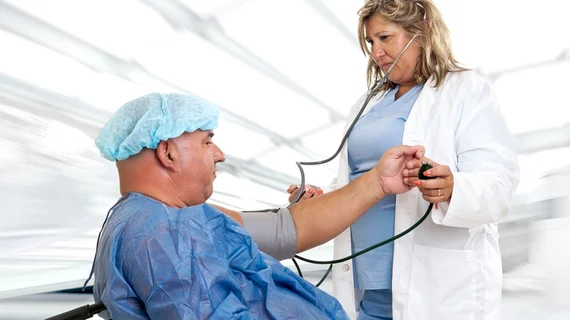A meta-analysis of sham-controlled renal denervation trials published in the Journal of the American College of Cardiology found the catheter-based procedure was associated with statistically significant drops in ambulatory and office blood pressure measurements among hypertensive patients.
Partha Sardar, MD, with Brown University in Providence, Rhode Island, and colleagues included six randomized trials with 977 total patients—582 undergoing renal sympathetic denervation (RSD) and 395 undergoing sham procedures. The average follow-up periods for the trials ranged from two to six months, and 24-hour ambulatory systolic blood pressure (ASBP) served as the primary endpoint.
In the pooled analysis, the reduction in 24-hour ASBP was 3.65 mm Hg greater with RSD than a sham procedure. Likewise, daytime ASBP (4.07 mm Hg difference), office systolic BP and office and ambulatory measures of diastolic BP were also lowered significantly more with renal denervation.
Notably, the reduction in daytime ASBP was significantly greater in the three second-generation trials included in the analysis (6.1 mm Hg more than sham) compared to the first-generation studies (2.1 mm Hg).
In a related editorial, three researchers questioned whether it was worth including both groups of trials in the same meta-analysis, given their differences. All the first-generation trials compared patients with treatment-resistant hypertension, whereas the second-generation studies didn’t require that caveat and two of them even kept patients off drug therapy prior to randomization.
Sardar and colleagues said the results of their meta-analysis could inform the design of future studies, which should more closely mirror the design of the second-generation trials.
“A large pivotal trial should be designed in a manner consistent with the second-generation trials included in this analysis,” they wrote. “These include minimization of participants with isolated systolic hypertension, performance of procedures by highly experienced operators, employment of more complete techniques of radiofrequency ablation, and use of other novel approaches such as endovascular ultrasound renal denervation.
“Also, based on our analysis, future large trials should include longer follow-up, be powered for efficacy endpoints including clinical outcomes, and incorporate objective measurement of medical adherence.”
The authors noted the BP reduction seen with RSD in their analysis is similar to that observed with either ACE inhibitors or calcium-channel blockers, antihypertensive medications that were associated with 22 percent and 18 percent risk reductions for major cardiovascular events, respectively, according to a 2013 meta-analysis published in The Lancet.
“If the benefit of renal denervation is consistently observed and durable in future large (randomized trials), its constant, always-on treatment effect might distinguish it from pharmaceutical treatments, which have many limitations, including drug intolerance, nonadherence, and variability in BP control due to trough levels,” Sardar et al. wrote.
Sverre E. Kjeldsen, MD, PhD, and co-authors suggested in their editorial an important next step is identifying the “extreme responders” to RSD—the 20 to 30 percent of patients who appear to derive the most dramatic benefits from the treatment.
“Interestingly, this holds true even in patients off medication, supposedly properly denervated,” wrote Kjeldsen, with the University of Oslo in Norway, and colleagues. “Therefore, this variability in response to RSD is either not or not only due to changes in drug treatment adherence or technical issues, but may reflect the variable contribution of the sympathetic system to BP elevation in the individual patient.”
With better patient selection and technical improvements, the authors predicted RSD could eventually break through the “glass ceiling of 6 mm Hg” and lower average systolic BPs even further.

